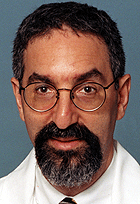Developing brain tumors can coax assistance from nearby cells known as microglia, according to a new study from School of Medicine scientists who have identified one protein made by microglia that helps accelerate tumor growth and are looking for others.

The results, published online in Human Molecular Genetics, come from a mouse model of neurofibromatosis 1 (NF1), a genetic condition that significantly increases childhood brain tumor risk. But senior author David Gutmann, M.D., Ph.D., the Donald O. Schnuck Family Professor of Neurology, said the findings also have implications for sporadic brain tumors, which affect many more people.
Gutmann, director of the Neurofibromatosis Center and co-director of the neuro-oncology program at Siteman Cancer Center, said scientists never really have had a good system for studying how microglia may contribute to general brain tumor formation.
“We’re going to use this model to better understand how brain cells that become tumors interact with microglia, and to probe how we might block those interactions,” he said.
Gutmann said he hopes to create approaches for shutting down microglia, which exist both in a resting state and an activated state. Tumors likely need microglia to be activated before they can convince them to send out growth signals. The tumor then exploits these signals to enable its rapid growth. If scientists can block microglia activation, they place the tumor’s potential partner in crime out of reach.
“From a therapeutic standpoint, we’re very focused in cancer therapy on poisoning the cancer cell,” Gutmann said. “But why not also deprive the cancer cell of the growth signals it receives from the normal surrounding tissue? These cells may actually decide whether a tumor forms at all and whether it continues to grow.”
To learn more about the neighboring cells’ effects on brain tumors, Gutmann turned to NF1, which affects more than 100,000 people in the United States. Gutmann has studied the condition for years both to help improve NF1 treatment and to develop insights into brain tumors generally. As part of that research, his lab developed a mouse model of NF1.
Brain tumors in human patients and in the mouse model arise from brain support cells known as astrocytes. Gutmann and his postdoctoral fellow Girish C. Daginakatte, Ph.D., studied these brain tumors early in their development to see if any other cell types were consistently nearby. They found microglia, a cell type they previously had noted in human tumor samples.
Microglia are similar to monocytes, immune system cells that circulate throughout the body. Scientists are debating the role of microglia.
“I think people recognize now that microglia can be both good guys and bad guys,” Gutmann said. “We’ve shown that they can definitely be subverted into a bad- guy role by tumors.”
When researchers gave the mice drugs that dampen immune system function and block activation of the microglia, tumor growth slowed. To determine what the microglia make that boosts tumor growth, they compared the proteins produced by microglia from the mouse model and from normal mice.
Among other differences, microglia from the mouse model made more of an enzyme called hyaluronidase. Other scientists previously identified hyaluronidase as a contributor to processes that trigger healing and regrowth after brain and spinal cord injury. Gutmann showed that hyaluronidase can promote astrocyte growth and that inhibiting microglia production of hyaluronidase slowed their growth-promoting effects.
“Now, we have to wait for pharmaceutical scientists to develop inhibitors of hyaluronidase activity that can be used as potential treatments,” Gutmann said. “In the meantime, though, we’ll be looking at other factors made by microglia to see if they’re also contributing to brain tumor growth as well as searching for ways to deactivate microglia.”